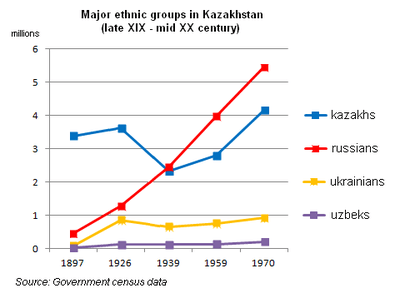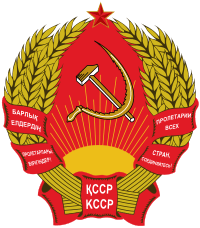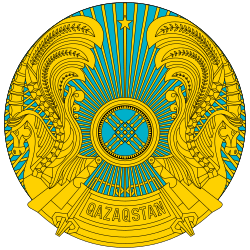Kazakh Soviet Socialist Republic
The Kazakh Soviet Socialist Republic[note 1] was one of the transcontinental constituent republics of the Soviet Union from 1936 to 1991 in northern Central Asia. It was created on 5 December 1936 from the Kazakh ASSR, an autonomous republic of the Russian SFSR.
Kazakh Soviet Socialist Republic[note 1] | |||||||||
|---|---|---|---|---|---|---|---|---|---|
| 1936–1991 | |||||||||
Anthem: "Қазақ Советтік Социалистік Республикасінің мемлекеттік гимні" "State Anthem of the Kazakh Soviet Socialist Republic" | |||||||||
 Location of Kazakhstan (red) within the Soviet Union | |||||||||
| Status | Soviet socialist republic | ||||||||
| Capital and largest city | Alma-Ata | ||||||||
| Official languages | Kazakh · Russian | ||||||||
| Minority languages | Uzbek · Uyghur · Tatar · Kyrgyz · Azerbaijani · Korean | ||||||||
| Demonym(s) | Kazakh Soviet | ||||||||
| Government | Unitary Marxist-Leninist single-party soviet republic (1936–1990) Unitary Marxist-Leninist presidential republic (1990–1991) | ||||||||
| Leader | |||||||||
• 1936–1938 | Levon Mirzoyan (first) | ||||||||
• 1989–1991 | Nursultan Nazarbayev (last) | ||||||||
| Premier | |||||||||
• 1936–1937 | Uraz Isayev (first) | ||||||||
• 1989–1991 | Uzakbay Karamanov (last) | ||||||||
| Legislature | Supreme Soviet | ||||||||
| History | |||||||||
• Elevation to a Union Republic | 5 December 1936 | ||||||||
| 16 December 1986 | |||||||||
• Sovereignty declared | 25 October 1990 | ||||||||
• Renamed Republic of Kazakhstan | 10 December 1991 | ||||||||
• Independence declared | 16 December 1991 | ||||||||
• Independence recognized | 26 December 1991 | ||||||||
| Area | |||||||||
| 1990 | 2,717,300 km2 (1,049,200 sq mi) | ||||||||
| Population | |||||||||
• 1990 | 16,711,900 | ||||||||
| Currency | Soviet ruble (руб) (SUR) | ||||||||
| Time zone | (UTC+4 to +6) | ||||||||
| Calling code | 7 31/32/330/33622 | ||||||||
| ISO 3166 code | KZ | ||||||||
| Internet TLD | .su | ||||||||
| |||||||||
| Today part of | Kazakhstan | ||||||||
| Eastern Bloc | |||||||
|---|---|---|---|---|---|---|---|
 | |||||||
|
Allied states
|
|||||||
|
Related organizations |
|||||||
|
Dissent and opposition
|
|||||||
Part of a series on the |
||||||||||||||||||||||||
|---|---|---|---|---|---|---|---|---|---|---|---|---|---|---|---|---|---|---|---|---|---|---|---|---|
| History of Kazakhstan | ||||||||||||||||||||||||
 | ||||||||||||||||||||||||
| Ancient | ||||||||||||||||||||||||
|
||||||||||||||||||||||||
| Khanates | ||||||||||||||||||||||||
|
||||||||||||||||||||||||
| Colonization and post-nomadic period | ||||||||||||||||||||||||
|
||||||||||||||||||||||||
| Topics | ||||||||||||||||||||||||
At 2,717,300 square kilometres (1,049,200 sq mi) in area, it was the second-largest republic in the USSR, after the Russian SFSR. Its capital was Alma-Ata (today known as Almaty). Today it is the independent nation of Kazakhstan. During its existence as a Soviet Socialist Republic, it was ruled by the Communist Party of the Kazakh SSR.
On 25 October 1990, the Supreme Soviet of the Kazakh SSR declared its sovereignty on its soil. Nursultan Nazarbayev was elected as president – a role he remained in for the next 29 years.
The Kazakh SSR was renamed the Republic of Kazakhstan on 10 December 1991, which declared its independence six days later, as the last republic to leave the USSR on 16 December 1991. The Soviet Union was disbanded on 26 December 1991 by the Soviet of the Republics. The Republic of Kazakhstan, the legal successor to the Kazakh SSR, was admitted to the United Nations on 2 March 1992.
Name
The country is named after the Kazakh people, Turkic-speaking former nomads who sustained a powerful khanate in the region before Russian and later Soviet domination. The Soviet Union's spaceport, now known as the Baikonur Cosmodrome, was located in this republic at Tyuratam, and the secret town of Leninsk (now known as Baikonur) was constructed to accommodate its personnel.
History
Formation
Established on August 26, 1920, it was initially called Kirghiz ASSR (Kirghiz Autonomous Soviet Socialist Republic) and was a part of the Russian SFSR. On April 15–19, 1925, it was renamed Kazak ASSR (subsequently Kazakh ASSR) and on December 5, 1936 it was elevated to the status of a Union-level republic, Kazakh Soviet Socialist Republic.
Between 1932 and 1933, as a consequence of enforced collectivisation and the disruption to the traditional nomadic lifestyle of many Kazakhs, a famine struck Kazakhstan, killing 1,500,000 people during the catastrophe of whom 1,300,000 were ethnic Kazakhs.
In 1937 the first major deportation of an ethnic group in the Soviet Union began, the removal of the Korean population from the Russian Far East to Kazakhstan. Over 170,000 people were forcibly relocated.
Over one million political prisoners from various parts of the Soviet Union passed through the Karaganda Corrective Labor Camp (KarLag) between 1931 and 1959, with an unknown number of deaths.[1]
During the 1950s and 1960s, Soviet citizens were urged to settle in the Virgin Lands of the Kazakh Soviet Socialist Republic. The influx of immigrants, mostly Russians, skewed the ethnic mixture and enabled non-Kazakhs to outnumber natives. As a result, the use of the Kazakh language declined, but has started to experience a revival since independence, both as a result of its resurging popularity in law and business and the growing proportion of Kazakhs. The other nationalities included Ukrainians, Germans, Jews, Belarusians, Koreans and others; Germans at the time of independence formed about 8% of the population, the largest concentration of Germans in the entire Soviet Union. Kazakh independence has caused many of these newcomers to emigrate.
Dissolution
Following the dismissal of Dinmukhamed Konayev, the First Secretary of the Communist Party of Kazakhstan by the last Soviet leader, Mikhail Gorbachev, the riots broke out for four days between December 16 to December 19, 1986 known as Jeltoqsan by student demonstrators in Brezhnev Square in the capital city, Alma-Ata. Approximately 168–200 civilians were killed in the uprising. The events were then spilled over to Shymkent, Pavlodar, Karaganda and Taldykorgan.
On March 25, 1990, Kazakhstan held its first elections with Nursultan Nazarbayev, the chairman of the Supreme Soviet elected as its first president. Later that year on October 25, it then declared sovereignty. The republic participated in a referendum to preserve the union in a different entity with 94.1% voted in favour. It did not happen when hardline communists in Moscow took control of the government in August. Nazarbayev then condemned the failed coup.
As a result of those events, the Kazakh SSR was renamed to the Republic of Kazakhstan on December 10, 1991. It became independent on December 16 (the fifth anniversary of Jeltosqan), becoming the last republic to secede from the USSR. Its capital was the site of the Alma-Ata Protocol on December 21, 1991 that dissolved the Soviet Union and formed the Commonwealth of Independent States in its place which Kazakhstan joined. The Soviet Union officially ceased to exist as a sovereign state on December 26, 1991 and Kazakhstan became an internationally recognized independent state.
On January 28, 1993, the new Constitution of Kazakhstan was officially adopted.
Population

According to the 1897 census, the earliest census taken in the region, Kazakhs constituted 81.7% of the total population (3,392,751 people) within the territory of contemporary Kazakhstan. The Russian population in Kazakhstan was 454,402, or 10.95% of total population; there were 79,573 Ukrainians (1.91%); 55,984 Tatars (1.34%); 55,815 Uyghurs (1.34%); 29,564 Uzbeks (0.7%); 11,911 Mordovans (0.28%); 4,888 Dungans (0.11%); 2,883 Turkmens; 2,613 Germans; 2,528 Bashkirs; 1,651 Jews; and 1,254 Poles.
| Ethnic Composition of Kazakhstan (census data)[2] | ||||||
|---|---|---|---|---|---|---|
| Nationality | 1926 | 1939 | 1959 | 1970 | 1979 | 1989 |
| Kazakh | 58.5 | 37.8 | 30.0 | 32.6 | 36.0 | 40.1 |
| Russian | 18.0 | 40.2 | 42.7 | 42.4 | 40.8 | 37.4 |
| Ukrainian | 13.88 | 10.7 | 8.2 | 7.2 | 6.1 | 5.4 |
| Belarusian | 0.51 | 1.2 | 1.5 | 1.2 | 1.1 | 0.8 |
| German | 0.82 | 1.50 | 7.1 | 6.6 | 6.1 | 5.8 |
| Tatar | 1.29 | 1.76 | 2.1 | 2.2 | 2.1 | 2.0 |
| Uzbek | 2.09 | 1.96 | 1.5 | 1.7 | 1.8 | 2.0 |
| Uyghur | 1.01 | 0.58 | 0.6 | 0.9 | 1.0 | 1.1 |
| Korean | 0.8 | 0.6 | 0.6 | 0.6 | ||
Famines
One of the greatest factors that shaped the ethnic composition of Kazakhstan was 1920s and 1930s famines. According to different estimates only in famine of 1930s, up to 40% of Kazakhs (indigenous ethnic group) either died of starvation or fled the territory.[3] Official government census data report the contraction of Kazakh population from 3.6 million in 1926, to 2.3 million in 1939.
Economy
Upon the start of the Second World War, many large factories were relocated to the Kazakh SSR.
The Semipalatinsk Nuclear Test Site and Baikonur Cosmodrome were also built here.
After the war, the Virgin Lands Campaign was started in 1953. This was led by Nikita Khrushchev, with the goal of developing the vast lands of the republic and helping to boost Soviet agricultural yields. However it did not work as promised, the campaign was eventually abandoned in the 1960s.[4]
Notes
- Historical names:
- 1936–1991: Kazakh Soviet Socialist Republic (Russian: Казахская Советская Социалистическая Республика; Kazakh: Қазақ Кеңестік Социалистік Республикасы, Qazaq Keńestik Sosıalıstik Respýblıkasy)
- 1991: Republic of Kazakhstan (Russian: Республика Казахстан; Kazakh: Қазақстан Республикасы, Qazaqstan Respýblıkasy)
References
- Peter Ford (May 25, 2017). "Dark Tourism in Kazakhstan's Gulag Heartland". The Diplomat.
- Dave, Bhavna (2012-03-11). "Minorities and participation in public life: Kazakhstan". Retrieved 2018-10-12.
- Валерий Михайлов: Во время голода в Казахстане погибло 40 процентов населения
- Durgin, Jr., Frank A. (1962). "The Virgin Lands Programme 1954–1960". Soviet Studies. JSTOR (13.3): 255–80.
External links
- Kazakhstan: Seven Year Plan for Prosperity by Dinmukhamed Konayev, a 1958 Soviet propaganda booklet



